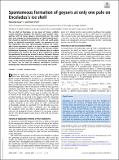Notice
This is not the latest version of this item. The latest version can be found at:https://dspace.mit.edu/handle/1721.1/133635.2
Spontaneous formation of geysers at only one pole on Enceladus’s ice shell
Author(s)
Kang, Wanying; Flierl, Glenn
DownloadPublished version (1.297Mb)
Publisher Policy
Publisher Policy
Article is made available in accordance with the publisher's policy and may be subject to US copyright law. Please refer to the publisher's site for terms of use.
Terms of use
Metadata
Show full item recordAbstract
© 2020 National Academy of Sciences. All rights reserved. The ice shell on Enceladus, an icy moon of Saturn, exhibits strong asymmetry between the northern and southern hemispheres, with all known geysers concentrated over the south pole, even though the expected pattern of tidal forced deformation should be symmetric between the north and south poles. Using an idealized ice-evolution model, we demonstrate that this asymmetry may form spontaneously, without any noticeable a priori asymmetry (such as a giant impact or a monopole structure of geological activity), in contrast to previous studies. Infinitesimal asymmetry in the ice shell thickness due to random perturbations are found to be able to grow indefinitely, ending up significantly thinning the ice shell at one of the poles, thereby allowing fracture formation there. Necessary conditions to trigger this hemispheric symmetry-breaking mechanism are found analytically. A rule of thumb we find is that, for Galilean and Saturnian icy moons, the ice shell can undergo hemispheric symmetry breaking only if the mean shell thickness is around 10 to 30 km.
Date issued
2020Journal
Proceedings of the National Academy of Sciences of the United States of America
Publisher
Proceedings of the National Academy of Sciences